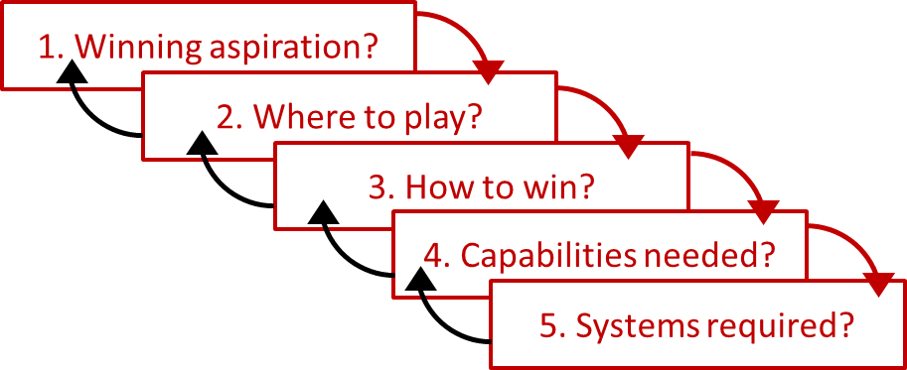I’ve bought 6 copies of this book over the last few years: Playing to Win: How Strategy Really Works (affiliate link). It was co-written by A.G. Lafley (ex-CEO of P&G) and Roger Martin (ex-Monitor, ex-Dean of Rotman School of Management) and breaks down strategy ideas clearly. You’ll see that I put a lot of things in “quotes” because they have a gift for saying a lot with few words. Pithy.
Strategy “is a set of choices about winning.”
So clear. It’s choices. Not one, but a set of self-reinforcing choices. Intention = winning, not just playing along, but winning. Winning at something specific.
Integrated cascade of choices
This is a a diagram from the book (pg 15 hardback) that I am re-creating here. It’s a set of 5 key questions to ask yourself. This can apply to your company, your department, or even your career. As the arrows indicate, the questions (and corresponding thinking) are inter-related. Of course, if you don’t know #1 what you are trying to do, then #3 you’re not going to come up smart ways to succeed. Likewise, you can’t be all things to all people, so you need to really #2 narrow down your focus to come up with #3 compelling ways to add value. Strategy is about sustainable competitive advantage so without #4 and #5, your victories will be sporadic and fleeting. From this diagram you also get the keen sense that this is a continual process. You can’t be a Southwest, Amazon, Chik-Fil-A, Cargill, Deloitte, P&G and succeed decade-after-decade without putting together a self-reinforcing set of activities that gives you a sustainable competitive advantage. Boom.

“Strategy is a Choice”
Strategy take times to do well. Look at the cascade of 5 questions above. What if you were to multiply that times 6-7 business units, 60+ countries, or scale that out to 300,000 employees. This take deliberate, consistent, and thoughtful trade-offs. You don’t stumble into a sustainable competitive advantage.
“It requires clear and hard thinking, real creativity, courage, and personal leadership. But it can be done. – Lafley & Martin
1. Winning aspirations?
Sure, this makes sense as a first step. Namely, what are we trying to do? How are we different from the half dozen companies and brands that resemble us? How are you going to break out the the generic label?
If you’ve been in the corporate world, you know there is a lot of corporate woo-woo talk about mission, vision, and culture. This also applies to the government and not-for-profit organizations. If “winning aspirations are statements about the ideal future”, this needs to quickly melt into questions like:
- What does winning look like to us?
- Who needs to be on the bus (hat tip: Jim Collins)?
- How do we know that we are winning?
2. Where to play?
This seems like a simple, almost innocuous, question – but there’s a fast and furious set of follow-on questions:
- Which geography?
- Which products and services?
- Which customer segments?
- What parts of the (sales) distribution channel?
- What parts of the (manufacturing) value chain?
A few example of these “where to play” decisions might be:
- Coca Cola launching their first alcoholic US market product in 2020 after 150+ years
- Starbucks finally entering Italy in 2018 after 45+ years (and 30,000 cafes globally)
Note: a lot of this thinking is a reflection of Michael Porter’s piece called “From Competitive Strategy to Corporate Strategy.” As a FYI, Roger Martin (co-author) spent many years at Monitor Consulting (founded by Michael Porter), which was then acquired by Deloitte.
3. How to compete and win?
Yes, strategy is how you cope with competition – not just from your rivals, but also from suppliers who are trying to raise prices, or customers who are threatening to switch to another carrier. Yes, this is the economic moat you are building around your business and profits. It’s your sustainable competitive advantage.
When analyzing an company’s strategy, some immediate questions might be:
- What’s the industry landscape (# of players, market concentration, profit profile) of the supplier, buyers, rivals?
- What are the regulatory environment or constraints (think: PESTEL)?
- Who are the target customer groups? What drives customer usage and demand? How to shape demand?
- What are they doing to protect our profits? Strategically valuable resources, capabilities, economic moat?
- What’s the strategic positioning in the minds of customers? Differentiation or cost?
- What’s the core competencies (resources + capabilities) which can create organic growth?
- Where’s the market headed? How to “skate to where the puck is headed”? (hat tip: Wayne Gretsky)
In my now forty-plus years in business, I have found that most leaders do not like to make choices. They’d rather keep their options open. . . In effect, by thinking about options instead of choices and defining winning robustly, these leaders choose to play but not to win. They wind up settling for average industry results at best. – A.G. Lafley
